The gastronomy of Buenos Aires is a testament to the melting pot of cultures that have shaped this city’s heart and spirit. From the indigenous influences to the waves of European immigrants, each has left an indelible mark on the flavors and traditions of Argentine cuisine.
As you navigate the bustling streets, from the historic barrios to the modern enclaves, Buenos Aires invites you to indulge in culinary adventures that echo the city’s diverse legacy.
For the digital nomads who transform cafes into offices and the travelers who seek to connect with the soul of every place they visit, Buenos Aires offers an unparalleled gastronomic landscape.
Here, food is more than sustenance; it’s a language of its own, a medium through which the city’s stories are told and retold. As you embark on this flavorful exploration with us, let ExpatPathways be your compass, guiding you to the heart of Buenos Aires’ culinary delights.
From the iconic asado gatherings that bring friends and families together to the sweet, comforting embrace of dulce de leche, every dish serves as a key to understanding the vibrant culture and warm hospitality that define Argentina.
Welcome to Buenos Aires, where every meal is an invitation to adventure and every flavor a memory in the making.
The most typical foods of Buenos Aires cuisine
1. Asado Argentino: A Grill Feast
The Argentine asado is more than just a meal; it’s a celebration born on the vast Pampas plains. Originating from gaucho culture, this grill feast melds intense flavors with the tradition of fire. The magic begins with select cuts of meat seasoned with salt and slowly cooked on the grill.
Juicy meats, whether ribs, tenderloin, or chorizo, become the centerpiece of gatherings among family and friends, accompanied by the iconic chimichurri, a fresh mix of garlic, parsley, vinegar, oil, and spices. This blend transports everyone to the very essence of Argentine cuisine, making the asado a communal experience that bridges past and present in Argentine culinary traditions.
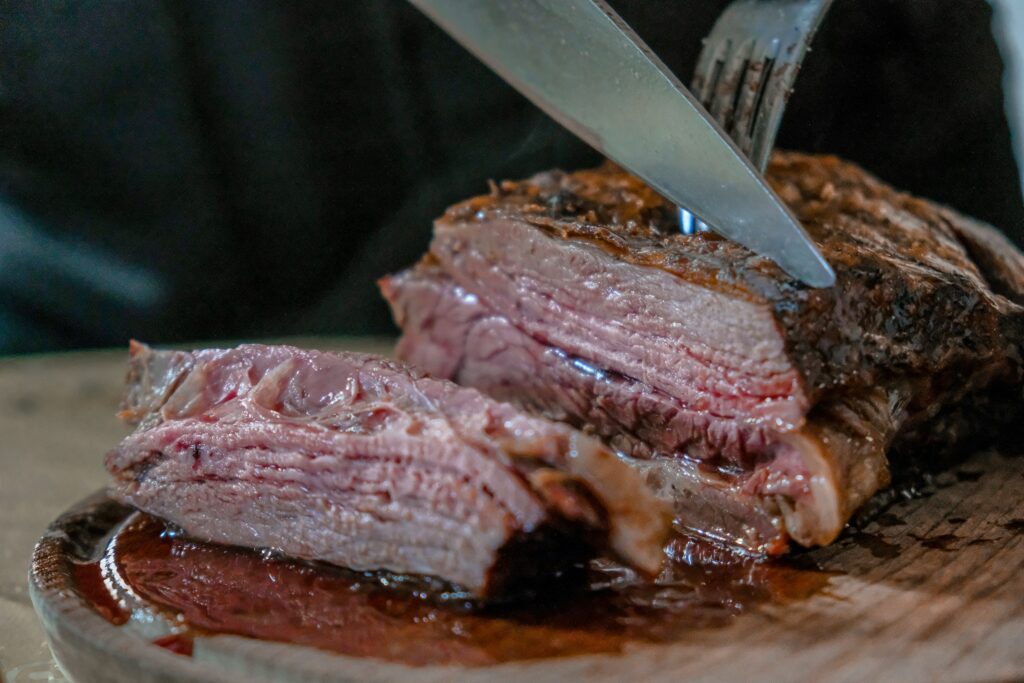
The best Argentine grills
- La Cabrera: A proud tribute to Rio de la Plata’s culinary culture, La Cabrera offers a unique gastronomic experience, awakening senses with its aromas and flavors. Located at José Antonio Cabrera 5099/5127, Palermo, Buenos Aires.
- Don Julio: Ranked #19 in the world’s 50 best restaurants of 2023, Don Julio delivers a remarkable meat taste complemented by wines, breads, and exceptional service. Provoleta and empanadas are a must-try. Find it at Guatemala 4699, Palermo Viejo, Buenos Aires.
- Fogón Asado: Celebrating Argentine heritage with pasture-raised meat, Fogón Asado offers a Michelin Guide 2024 listed experience with tasting menus that blend Argentine classics with creative twists. Visit at Uriarte 1423, Palermo, Buenos Aires.
2. Empanadas: Stuffed with Tradition
Empanadas, those small wonders filled with flavor, have won over Argentine hearts since time immemorial. With origins tracing back to Spanish and Italian kitchens, these portable delights have deeply rooted themselves in Argentina’s culinary identity.
The crispy dough, whether baked or fried, envelops varied fillings from juicy meat to vegetarian options like spinach and cheese. With shapes and styles varying by region, empanadas are the perfect snack for any occasion, embodying the rich tapestry of Argentine culture in every bite.
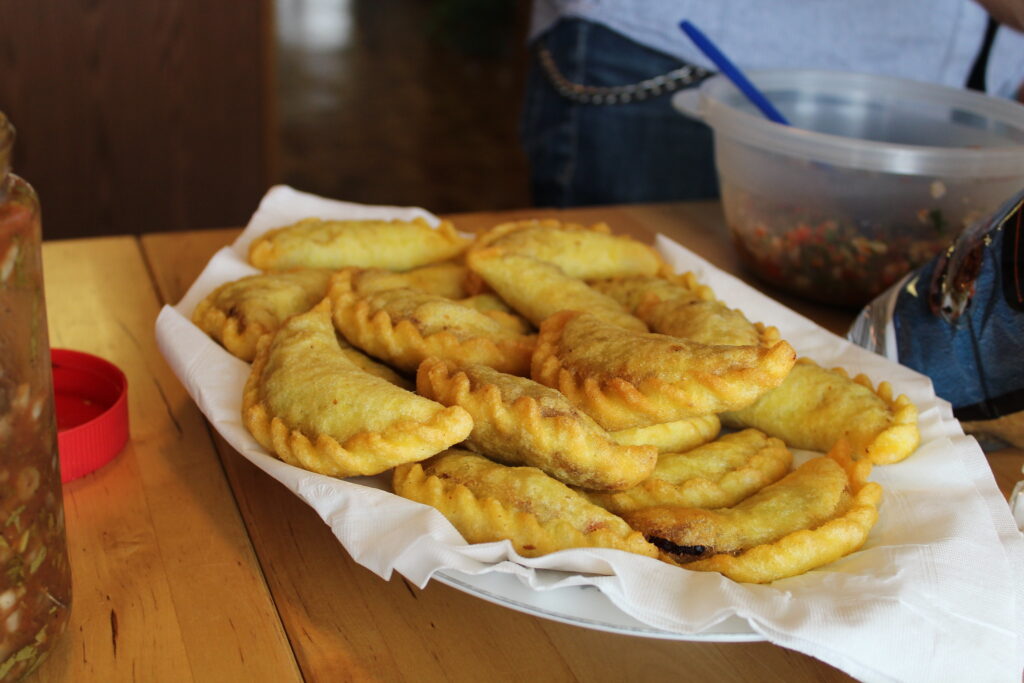
The best empanada places
- Mi Gusto: A culinary phenomenon in Palermo, Mi Gusto reinvents empanadas with unique flavors and a creative twist of parmesan gratin, beloved by over 270,000 Instagram followers. Find them at Av. Cnel. Niceto Vega 5795.
- La Mezzetta: Esteemed since 1939 in Villa Ortúzar, La Mezzetta, known for winning the title of best pizzeria and serving the best fugazzeta in Buenos Aires, captured hearts again in a Netflix Street Food episode. Located at Av. Álvarez Thomas 1321.
- La Cocina: Offering the finest Corrientes and Catamarqueñas empanadas in Buenos Aires, La Cocina stands out for its juicy and delicious fillings like onion and cheese or the spicy and surprising Picachu. A must-visit spot at Avenida Pueyrredón 1508, Recoleta for a quick, flavorful bite.
3. Mate: A Social Elixir with History
Mate, more than a beverage, is a ritual that weaves bonds among friends and family. Originating from indigenous cultures, this social elixir has set the rhythm of daily life in Argentina. Prepared with yerba mate leaves, mate is shared in social circles, fostering camaraderie.
The act of pouring hot water over the yerba, known as “cebado,” is crucial for extracting the perfect balance of flavors. Mate transcends its role as a mere drink, symbolizing hospitality and human connection, marking it as a cornerstone of Argentine social life.
4. Milanesa: Crispy and Flavorful, an Adopted Italian Tradition
The Argentine milanesa pays homage to Italian traditions, creating a dish that marries the tenderness of meat with a golden crispy coating. This culinary journey across time and the Atlantic has resulted in a delicious adaptation of Italian cuisine.
Simple ingredients like beef, chicken, or veal are breaded with a mixture of egg, breadcrumbs, and seasonings, then fried to achieve a crunchy and golden exterior. Commonly served with French fries or as a sandwich, the milanesa is a comforting classic that has captured Argentine hearts.
The best restaurants in Buenos Aires to savor a crispy Milanese
- Bodegón El Obrero: An iconic spot in La Boca, known for its delicious milanesas, generous portions, and family-friendly atmosphere, El Obrero stands out as a culinary gem. Located at Agustín R. Caffarena 64.
- Manolo: Nestled in the heart of San Telmo, Manolo boasts one of the city’s best milanesas, making it an essential stop for both tourists and locals. Its classic bodegón setting adds to its appeal. Find it at Bolívar 1299, San Telmo.
- El Ferroviario: Famous for its giant milanesa and all-you-can-eat grill menu, El Ferroviario is a celebrated bodegón in Liniers, embodying the spirit of the local football club Vélez Sarsfield. Visit at Av. Reservistas Argentinos 219.
5. Humita en Chala: Andean Delicacy Wrapped in Corn Husks
Humita en chala is a delicacy that blends Andean flavors with gaucho tradition, offering a burst of corn encased in corn husks. This dish reflects Argentina’s culinary diversity, with a special nod to indigenous influences.
Prepared with ingredients like corn, onion, cheese, and spices, the mixture is wrapped in corn husks and steamed. The result is a tender and aromatic bite that pays homage to the country’s cultural and culinary richness, showcasing the versatility of Argentine gastronomy.
Best northern Argentine food restaurants
- Molino Norteño: A standout destination for authentic Northern Argentine cuisine, offering everything from tamales to locro with true northern flavor. Don’t miss the quesillo con cayote, a rare find in Buenos Aires, located at Coronel Apolinario Figueroa 101.
- El Imperfecto: Nestled in Palermo, this wood-fired kitchen, El Imperfecto, serves dishes infused with the passion of its owners, offering a culinary journey to the North with every bite. Find it at Gascón 1417, and experience the flavors of Catamarca, Jujuy, and Salta in a historic house setting.
- Rincón Norteño: Dedicated to reviving the authentic, artisanal flavors of Northern Argentina, Rincón Norteño is celebrated for its empanadas, known for their delicious taste and size, making a mark in the culinary scene. Visit at José A. Cabrera 3500.
6. Matambre Pizza: Merging Gaucho and Italian Traditions
Matambre Pizza is a unique fusion that blends gaucho tradition with Italian influence, creating a feast of flavors that reflect Argentina’s rich culinary heritage. Originating from the Argentine Pampas, matambre is seasoned with spices and herbs, placed on a pizza base, and grilled.
This combination of carnivorous flavors with the comforting essence of traditional pizza showcases the creativity and adaptability of Argentine cuisine, making it a beloved dish among locals and visitors alike.
You can enjoy the best matambre pizza at Los Chanchitos. This Buenos Aires food restaurant is an emblem of the City of Buenos Aires. Its dishes are abundant and offer diners the most representative flavors of Buenos Aires gastronomy.
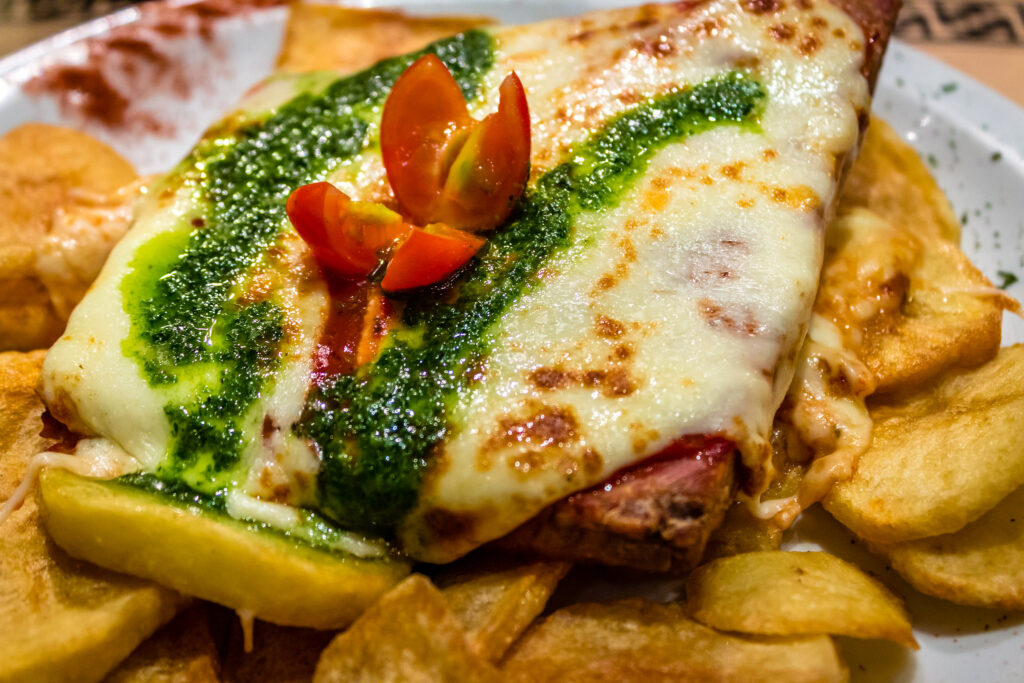
7. Choripán: The Flavor of Street and Grills
Choripán, an Argentine classic, perfectly fuses chorizo with bread. This street food favorite, beloved at fairs and grills, pays tribute to simplicity and the deliciousness emerging from gaucho traditions.
Grilled chorizo is served in crispy bread and topped with chimichurri, lettuce, and tomato, offering a quick bite full of authentic Argentine flavor. Choripán embodies the country’s culinary spirit, making it a must-try for anyone seeking a taste of Argentina’s street food culture.
The most incredible choripanes in Buenos Aires
- Desnivel: A bustling traditional family bodegón in San Telmo, Desnivel is famed for its aromatic choripán, alongside other signature dishes like milanesa napolitana. Located at Defensa 855, it’s a magnet for international visitors.
- La Dorita: With over fifteen years in Buenos Aires and branches in Puerto Madero, Palermo, and Belgrano, La Dorita stands out for its Choricampi, a unique chorizo wrapped in homemade field dough, served with salsa criolla and chimichurri. Find it in various locations including Pierina Dealessi 1350.
- Lo de Charly: An authentic choripán experience in Buenos Aires, open 24/7 for over 30 years. Lo de Charly, located in Villa Urquiza at Avenida Álvarez Thomas 2101, is a beloved spot for its grill specialties and the classic choripán, offering a taste of local life.
8. Dulce de Leche: The Milky Treasure Sweetening Palates
Dulce de leche, Argentina’s liquid gold, captivates palates with its sweetness and creamy texture. This milky treasure, with roots dating back to the 19th century, has become a hallmark of Argentine pastry. Prepared with milk, sugar, and vanilla, it’s slowly cooked until it reaches a caramelized, creamy consistency.
Enjoyed in various forms, from alfajores filling to dessert accompaniment, dulce de leche is a testament to Argentina’s love for sweets, enriching the culinary landscape with its indulgent flavor.
Three brands of dulce de leche to enjoy
- Vacalin: A leader in the industrial dulce de leche market, Vacalin boasts a 100% Argentine flavor with a smooth and unique texture. Expanding its presence, Vacalin is opening retail outlets across Buenos Aires to bring its products closer to local residents.
- San Ignacio: Renowned for captivating both local and international taste buds, San Ignacio processes over 27 million liters of milk annually to produce its high-quality dulce de leche, cheeses, and fresh products. With a tradition and quality that make it a preferred choice, San Ignacio offers various styles, including classic creamy versions and innovative flavors like banana and chocolate.
- Milkaut: Despite its name, Milkaut is not associated with the chocolate brand Milka. Known for its creamy yet slightly sugary texture, this dark and intense dulce de leche might be too rich for those sensitive to sweetness.
9. Potato cake: Comfort in Every Layer
The Potato cake, a comforting dish par excellence, finds its origins in European cuisine adapted to Argentine tastes. Layer upon layer of mashed potatoes and seasoned meat bake to perfection, offering a warm embrace with every bite.
This dish, with its alternating layers of potatoes and seasoned meat, often with onions and spices, brings the comforting warmth of home cooking to the table, making it a cherished meal for family gatherings.
The best Buenos Aires cantinas to enjoy a delicious potato pie
- La Capitana: Offers traditional dishes along with vegan and gluten-free options, but their claim to fame is “the best potato pie in the world,” inspired by Juan Domingo Perón’s favorite, featuring creamy mashed potatoes and shredded beef with homemade barbecue sauce, baked in a clay oven and topped with smoked cheese. Located at Guardia Vieja 4446, Almagro.
- Los Galgos: A vintage culinary hotspot, where chef Magalí Sanchi creates a unique potato pie from roast beef braised for six hours, then sautéed with green onions, embodying a nostalgic flair. Find it at Callao 501, Buenos Aires.
- El Preferido de Palermo: Distinguished by hand-picked and ground shoulder meat, their potato pie includes a touch of white wine and green peppers, alongside the traditional red pepper, aiming for a classic status. Visit at Jorge Luis Borges 2108, Palermo.
10. Locro: Authentic Flavor in a Traditional Stew
Locro, the emblematic stew of Argentina, is a hearty blend of corn, meat, vegetables, and legumes. With indigenous roots and a Criollo touch, this comforting dish is a celebration of the country’s cultural diversity.
Ingredients like corn, pork, pumpkin, and spices are slow-cooked until flavors meld together, making locro a winter favorite that warms the soul and honors Argentine tradition with every spoonful.
Where to enjoy a typical Argentine locro?
- 1810 Cocina Regional Palermo: Celebrated for offering the best of traditional Argentine cuisine, including year-round locro, amidst a cozy and clean ambiance. Known for exquisite regional dishes, homemade empanadas, and a variety of regional desserts. Located at Julian Alvarez 1998, Ciudad de Buenos Aires.
- El Sanjuanino: A top choice for those craving authentic locro, El Sanjuanino serves generous portions with perfect flavors and ingredients, reminiscent of the countryside. The bustling, compact space offers traditional dishes at moderate prices. Find it at Sanchez de Bustamante 1788, Buenos Aires.
- Bar Polo: A bodegón on a perfect corner with fresh daily menus, Bar Polo is a great place for dining due to its affordable prices, quality service, and delicious food, including abundant portions and rich flavors. Located at Avenida Scalabrini Ortiz 702, Buenos Aires.
11. Alfajores: Sweet Delight between Two Layers of Love
Argentine alfajores are pastry jewels that have won over both locals and visitors. These delights, featuring two layers of soft dough filled with sweetness, are unmistakable symbols of Argentine gastronomy. The dough, typically a blend of flour, cornstarch, and butter, is baked to achieve a soft yet slightly crunchy texture.
The filling varies from dulce de leche to chocolate or fruit, and some alfajores are dipped in chocolate or dusted with powdered sugar, making them perfect treats to satisfy cravings and sweeten any moment.
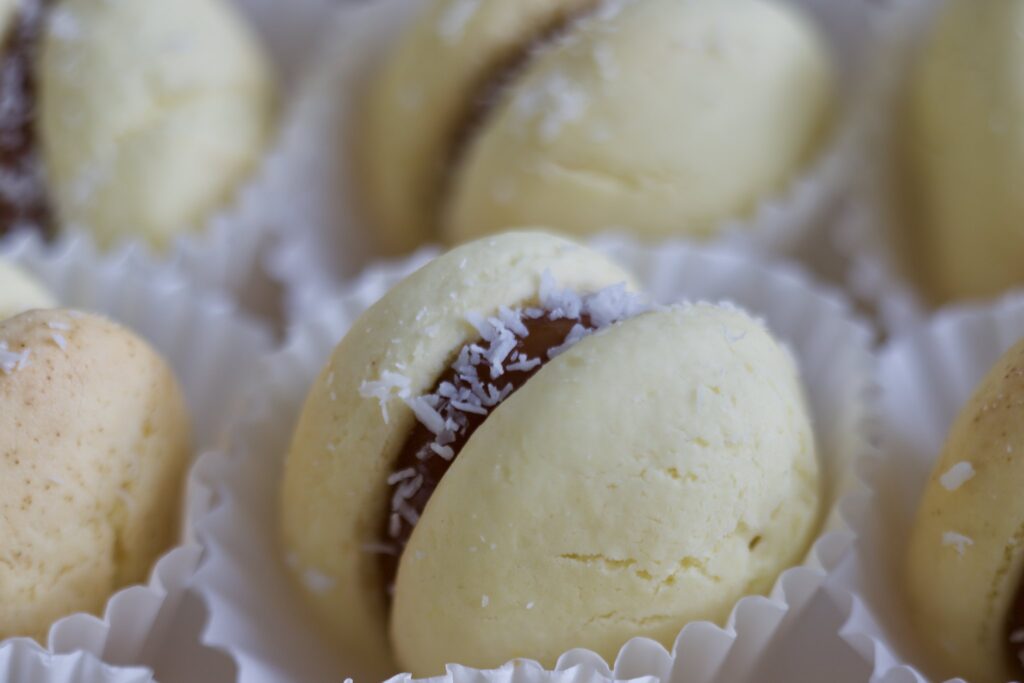
The best 5 brands of Argentine alfajores
- Havanna: Originating from Mar del Plata, Havanna has revolutionized the Argentine palate with its diverse alfajor offerings, from classic dulce de leche and chocolate to fruit and mousse flavors.
- Guaymallén: Known for its excellent value, Guaymallén offers an affordable and simple selection of alfajores, perfect for enjoying on the go or during a leisurely walk.
- Milka: Famous for its rich chocolate coating, Milka initially focused on chocolate mousse alfajores but has since expanded its range to include dulce de leche, white chocolate, and more.
- Terrabusi: A symbol of Argentine alfajores, Terrabusi offers soft, classic, and delicious options without venturing into exotic flavors, catering to all ages in Buenos Aires.
- Águila: Known as “mini-cakes” due to their size, Águila’s alfajores stand out for their chocolate sponge cake filled with cream and dulce de leche, all enveloped in dark chocolate.
12. Medialunas: Argentines’ Sweet Breakfast
Medialunas, the sweet and fluffy croissants, are essential to the Argentine breakfast table. Inspired by French pastry, these treats have carved out their own identity in Argentina’s culinary heart.
Prepared with flour, sugar, butter, and yeast, medialunas are baked until golden and crispy, often served dusted with powdered sugar or filled with dulce de leche, providing a sweet and comforting start to the day, reflecting the blend of European influences and local tastes in Argentine cuisine.
Bakeries where you can enjoy the best Buenos Aires croissants
- Confitería Delgado: With over 50 years of tradition, this family-run bakery in Buenos Aires is renowned for its quality, attention to detail, and warm service. Known for employing the finest bakers and pastry chefs, it has branches in Almagro, Villa Crespo, Barrio Norte, La Boca, and Congreso.
- Las Violetas: Located at Avenida Rivadavia 3899, Las Violetas offers a rewarding experience with a rich history. Patrons can enjoy a variety of baked goods and pastries, such as factura pastries, cakes, sandwiches de miga, and puddings, perfect for pairing with coffee.
- Madre Panadería: At Malabia 440, Buenos Aires, this bakery stands out for its excellent customer service and a wide range of bakery products, from bread to alfajores, croissants, and chocolate bread. It’s praised for its generous portions and great value.
- Gustado’s: Situated at Av. Gaona 1731, Buenos Aires, Gustado’s offers an array of sweet and savory options, including cakes, fine pastries, empanadas, and sandwiches. It’s recognized for its variety and quality of products, along with exceptional bakery and pastry offerings.
13. Gnocchi from 29: Tradition and Prosperity on a Plate
Gnocchi from 29, a tradition deeply embedded in Argentine culture, are enjoyed on the 29th of each month. This superstition, involving placing money under the plate for prosperity, turns ñoquis into a meaningful and flavorful dish.
Made with mashed potatoes, flour, and egg, the ñoquis are boiled and served with various sauces, such as classic tomato or creamy mushroom sauce. This blend of tradition, belief, and flavor makes Gnocchi from 29 a unique and special meal, embodying the spirit of Argentine hospitality and culinary richness.
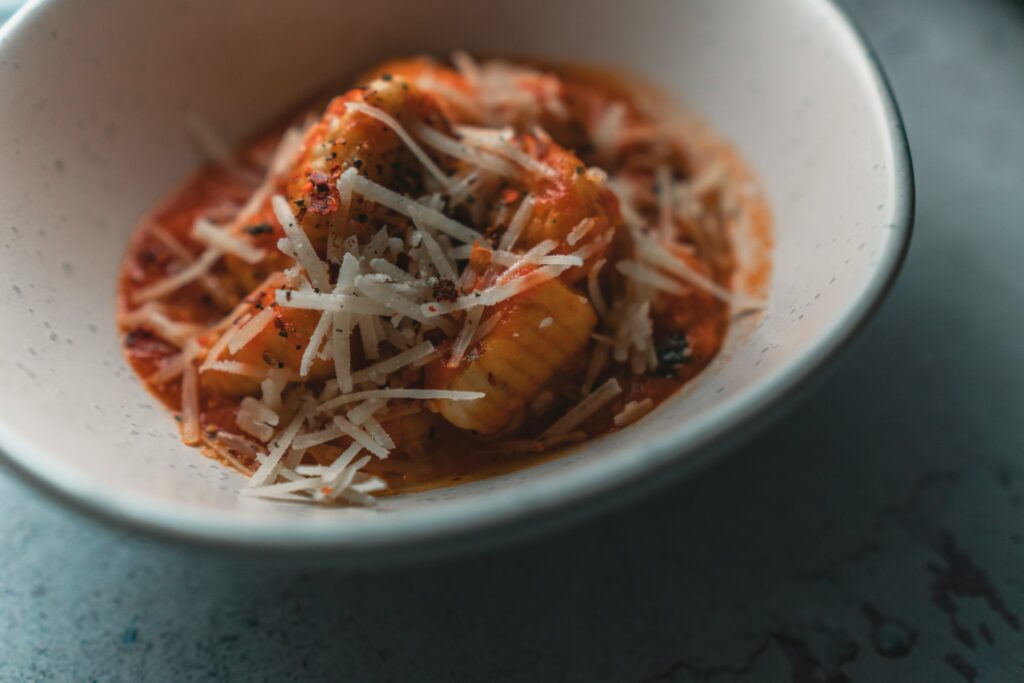
The best pasta restaurants in Buenos Aires
- La Alacena: Founded 6 years ago by Julieta Oriolo and Mariana Bauzá, this restaurant at Gascón 1401, C1181ADA, Buenos Aires, showcases Italian culinary traditions with dishes like braised veal ravioli and lasagna alla Bolognese “Carmelia.” Made with semolina, 00 flour, and farm eggs, the pasta reflects the chef’s Italian roots. Open for outdoor lunches and planning for dinners, it also offers special takeaway dishes.
- Il Gran Caruso: Esteemed for its wide range of pasta dishes, Il Gran Caruso is located at El Salvador 5805, C1414BQI Buenos Aires. It boasts excellent service and a prime location. Menu highlights include gluten-free spaghetti, tortellis di zuca, coconut flan, and chocolate marquise with ice cream, providing a memorable dining experience with dishes like Ravioli Della Nonna Margherita and Moka Volcano dessert.
- La Parolaccia: With roots in Rome’s Trastevere and over 28 years in Argentina, La Parolaccia offers a dining experience true to its origins of quality and hospitality at various locations in Buenos Aires (Palermo, Recoleta, Avenida Libertador, San Isidro, Puerto Madero, Pilar). The menu features pasta prominently, catering to discerning tastes and maintaining the true essence of Italian cuisine.
14. Patagonian Lamb: Delight from the Southern Lands
Patagonian lamb, a delicacy from the vast and pristine southern lands of Argentina, offers robust flavor and tender texture, reflecting the abundance of the region and the skill of Patagonian grill masters. Grilled or roasted, seasoned with local herbs and spices, the lamb becomes a feast for meat lovers.
This Patagonian delight introduces the culinary diversity of Argentina, bringing the essence of the region to every bite and showcasing the country’s rich gastronomic landscape.
The most exclusive grills in Buenos Aires
- Grandes Carnicerías del Plata: Located at Chile 592, this steakhouse occupies a former butcher shop at the corner of Chile and Peru streets. It merges contemporary ambiance with historical elements like the original “gancheras,” white tiles, and calcareous mosaic floors, offering a delicious menu on a generous sidewalk where diners can enjoy the view.
- Parrilla Aires Criollos: Situated on Avenida Santa Fe 1773 in Barrio Norte, Aires Criollos is known for serving the best of Argentine grilled meats in an environment that celebrates Argentine tradition, complete with personalized service and a culinary offering that includes traditional cuts and dishes, as well as homemade pasta, all amidst authentic local decor.
- La Estancia Asador Criollo: Just steps from the Obelisco at Lavalle 941, La Estancia Asador Criollo has been a Buenos Aires classic since 1962, offering a quintessentially Argentine experience beside the grill. Known for its dedication to quality and service, highlights include Patagonian lamb and goat cooked on a stake.
15. Fernet with coca: A Unique and Refreshing Toast
Concluding our gastronomic tour through Argentina, we must highlight Fernet with coca, the iconic drink that has captured the hearts of Argentines. This beverage, mixing the bitterness of Fernet with the sweetness of Coca-Cola, symbolizes social gatherings and celebrations.
Served with ice and an optional slice of lemon, the mix offers a balanced blend of flavors that refreshes and delights. Whether at a friendly gathering or as a relaxed evening drink, Fernet with coca is the perfect toast to end a day full of Argentine flavors, embodying the country’s vibrant and welcoming spirit.
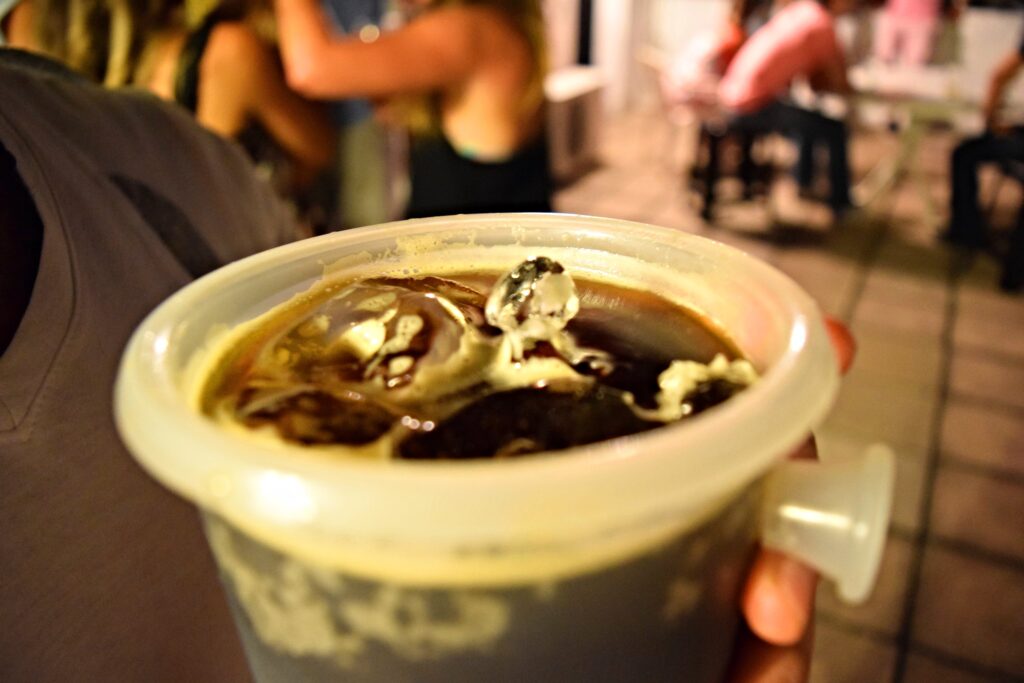
The best places to taste Fernet and other cocktails
- 878 Bar: Located in Villa Crespo at Thames 878, this bar has made a name for itself with innovative vermouth cocktails like “De los Andes a Villa Crespo,” and a menu that challenges you to choose just one “vermutero” drink or accompanying dish. Its ambiance mixes contemporary with traditional, highlighted by the vermouth’s starring role on the cocktail list.
- Casa María Vermutería: At the Palermo Viejo corner of Honduras 6055, Casa María blends musical ambiance with vermouth-infused culinary delights. Favorites include the “Ferroviario” cocktail, featuring fernet, soda, and Vermú Rosso with a grapefruit garnish, alongside dishes like “Montadito de paté al vermú,” offering a unique twist on traditional snacks.
- La Fuerza Bar & Vermú: Known synonymously with vermouth in Argentina, La Fuerza at Avenida Dorrego 1409, Chacarita, invites guests to enjoy “Vermucócteles” like “La Fuerza Spritz” on its terrace. They also offer a taste of local cuisine with dishes such as “tortilla de papa y morcilla,” ensuring a robust vermouth experience that extends even to your home with recipes available on their website.
(Featured Image Source: Fede Espinoza/flickr.com)


